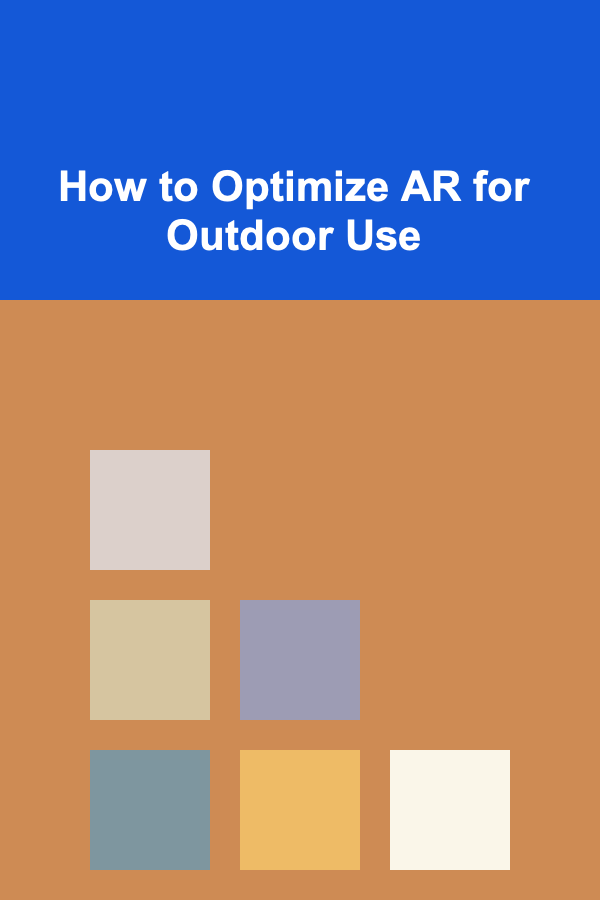
How to Optimize AR for Outdoor Use
ebook include PDF & Audio bundle (Micro Guide)
$12.99$10.99
Limited Time Offer! Order within the next:

Augmented Reality (AR) has revolutionized the way we interact with the world around us, allowing us to overlay digital information on top of the real world. While AR technology has seen significant advancements over the years, outdoor use presents unique challenges that require specific optimization strategies. In this article, we'll explore the key considerations and techniques for optimizing AR for outdoor environments, focusing on aspects such as visibility, battery life, accuracy, and user experience.
The Challenges of AR in Outdoor Environments
AR for outdoor use faces several challenges that differ from indoor AR applications. Some of the most notable challenges include:
1. Environmental Lighting
Outdoor environments have unpredictable lighting conditions, with factors like direct sunlight, shadows, and changing weather. Sunlight can be particularly harsh, washing out screens and making it difficult to see the AR content clearly. On the other hand, in shaded areas or during the night, insufficient lighting can degrade the quality of the AR experience.
2. Battery Life
AR applications tend to be resource-intensive, utilizing multiple sensors, GPS, cameras, and real-time processing to generate the augmented experience. Outdoor usage often exacerbates this issue due to the need for constant GPS and network updates, leading to faster battery drain. This is especially problematic in situations where users may be far from charging stations.
3. Tracking Accuracy
AR systems rely on sensors like cameras and accelerometers to track a user's position and movements. However, GPS accuracy can be compromised in certain outdoor settings, particularly in areas with poor satellite visibility, such as dense urban environments, mountainous regions, or areas with heavy foliage. This can lead to inaccuracies in AR positioning and a degraded user experience.
4. Network Connectivity
Many AR applications rely on constant connectivity to the internet, whether for streaming data, cloud processing, or real-time updates. Outdoor environments, especially in remote areas, may suffer from weak or unreliable cellular signals, which can hinder the performance of AR applications that depend on high-bandwidth connections.
5. User Interaction and Safety
Outdoor AR applications often require users to move around, interact with physical environments, and engage in tasks that require their attention. Ensuring that users can interact with AR content in a way that is intuitive, safe, and non-intrusive is a significant challenge. Users must remain aware of their surroundings, especially in outdoor settings with potential physical hazards.
Optimizing AR for Outdoor Use
Given the challenges outlined above, several strategies can be employed to optimize AR experiences for outdoor environments. Below are some essential considerations and techniques for optimizing AR for outdoor use.
1. Improving Display Visibility
One of the most pressing concerns in outdoor AR is ensuring that digital content is visible and legible in various lighting conditions. To address this challenge, several display technologies and techniques can be employed:
a. High-Contrast Displays
High-contrast displays, particularly those using OLED or AMOLED technology, can improve visibility in bright sunlight. OLED screens provide deeper blacks and more vibrant colors, which can make AR content more readable in outdoor conditions. Optimizing the contrast ratio in AR applications can significantly enhance the user experience by ensuring that digital content remains visible even in direct sunlight.
b. Adaptive Brightness and Contrast
Modern AR devices can incorporate adaptive brightness sensors that adjust the display's brightness and contrast based on the surrounding light conditions. This ensures that the screen is not too dim in dark environments or too bright in sunlight. Automatic adjustments to brightness and contrast can reduce the need for manual intervention and improve the overall user experience.
c. Polarizing Filters
Polarizing filters can be integrated into the AR glasses or displays to reduce glare and reflections caused by sunlight. This technology works by blocking certain light waves, resulting in clearer and more visible screens. For outdoor AR, particularly in environments with a lot of sunlight, polarizing filters can be extremely beneficial.
d. Transflective Displays
Transflective displays are a combination of reflective and transmissive displays. These displays reflect ambient light to improve visibility in bright outdoor environments, while also being transmissive when indoor lighting is available. Transflective displays can be particularly useful for AR applications that need to work in both indoor and outdoor settings.
2. Optimizing Battery Life
Battery life is a critical factor in the outdoor use of AR applications. AR devices often require continuous power to run their sensors, displays, GPS systems, and network connections. Below are some strategies to optimize battery life for outdoor AR use:
a. Low Power Components
Using energy-efficient components, such as low-power processors, sensors, and displays, can help reduce the energy consumption of AR devices. Many AR applications use powerful processors that drain battery life quickly, but opting for more energy-efficient hardware can significantly extend the device's operational time.
b. Power Management Algorithms
Implementing power management algorithms can help optimize battery usage. For example, the system can detect when the AR application is not in use or when certain sensors are not required (such as turning off the GPS when the user is stationary) and reduce power consumption accordingly.
c. Battery Optimization Features
Developers can build AR applications with battery optimization in mind. This can include features like adjusting the refresh rate of the display based on the level of activity or reducing the frequency of sensor updates when the user is stationary. Allowing the system to intelligently manage power consumption can help prolong battery life.
d. Solar Charging
For extended outdoor use, integrating solar charging capabilities into AR devices or accessories (such as wearable AR glasses) can help reduce dependency on traditional charging sources. Solar panels embedded in the device can provide supplemental power during outdoor activities, allowing users to stay engaged in AR experiences for longer periods.
3. Enhancing GPS and Tracking Accuracy
GPS and sensor tracking are crucial for AR applications, especially in outdoor environments where users rely on their location to interact with digital content. However, GPS accuracy can be affected by various environmental factors. The following techniques can improve tracking accuracy:
a. Multi-Sensor Fusion
One way to improve tracking accuracy is by using a combination of sensors, such as GPS, accelerometers, gyroscopes, and magnetometers, in tandem. This multi-sensor approach allows the AR system to compensate for inaccuracies in one sensor by using data from the others. For example, when GPS signals are weak, the accelerometer and gyroscope can help track the user's movement more accurately.
b. Augmented GPS with Local Beacons
In areas where GPS signals are weak or unreliable, such as urban canyons or dense forests, local beacons or Wi-Fi triangulation can be used to augment GPS data. These beacons can communicate with the AR device to provide more precise location data, ensuring that the AR content is properly aligned with the real world.
c. Real-Time Map Updates
In outdoor AR applications, real-time map updates can help improve the accuracy of positioning data. By incorporating dynamic maps into the AR experience, users can receive real-time updates about their location and surrounding environment. This helps ensure that the AR system is always aligned with the user's current position, even in challenging environments.
d. Use of Visual Recognition
In addition to GPS and sensor data, visual recognition technologies can be employed to improve AR tracking accuracy. By using the device's camera to recognize landmarks, objects, or environmental features, the AR system can more accurately position digital content in the real world. This is especially useful in environments where GPS signals may be weak or inaccurate.
4. Improving Network Connectivity
Many outdoor AR applications require internet connectivity to function, whether for streaming content, accessing cloud-based processing, or interacting with other users. To optimize AR for outdoor use, it's essential to address issues related to network connectivity:
a. Offline Functionality
One way to mitigate the challenges of network connectivity is by enabling offline functionality in AR applications. By allowing certain features to be preloaded or cached, users can continue using the AR application even in areas with poor or no internet connectivity. Offline functionality can be particularly useful in remote outdoor environments or during outdoor activities like hiking and camping.
b. Edge Computing
Edge computing allows data processing to take place closer to the user, reducing the reliance on cloud-based processing. By processing data locally on the device or on nearby edge servers, AR applications can minimize the need for constant internet connectivity. This helps ensure that the AR experience remains smooth and uninterrupted, even in areas with limited network coverage.
c. 5G Connectivity
The rollout of 5G networks promises faster and more reliable internet connectivity, especially in outdoor environments. AR applications can benefit from 5G's low latency and high bandwidth, allowing for faster data transfer and more immersive real-time experiences. As 5G coverage continues to expand, it will improve the performance and accessibility of AR applications in outdoor settings.
5. User Interaction and Safety
Outdoor AR applications often require users to interact with physical environments, which can pose safety risks. Optimizing user interaction and ensuring safety is a top priority when designing outdoor AR experiences.
a. Context-Aware Interactions
Context-aware interactions allow the AR system to adjust its behavior based on the user's environment and situation. For example, if the user is walking through a busy city street, the AR system can adjust the display to minimize distractions and keep the user aware of their surroundings. Similarly, if the user is hiking in a forest, the system can provide relevant information about the environment without interfering with the user's safety.
b. Hands-Free Interaction
Outdoor AR applications often require users to keep their hands free for physical tasks, such as holding onto a railing, steering a bike, or interacting with objects in the environment. To accommodate this, AR systems should support hands-free interactions, such as voice commands or gesture-based controls. This ensures that users can engage with the AR content without compromising their safety or comfort.
c. Safety Alerts
AR systems can incorporate safety alerts to notify users of potential hazards in their surroundings. For example, an outdoor AR app could alert the user if they are approaching a cliff edge, crossing a busy street, or encountering a dangerous animal. These alerts can help ensure that users remain aware of their environment while enjoying the AR experience.
Conclusion
Optimizing AR for outdoor use involves addressing several unique challenges, from environmental lighting and battery life to tracking accuracy and network connectivity. By employing advanced display technologies, energy-efficient hardware, multi-sensor tracking systems, and context-aware interactions, developers can create AR experiences that are both immersive and practical for outdoor environments.
As AR technology continues to evolve, outdoor applications will become increasingly commonplace, enhancing activities like navigation, tourism, sports, and education. By addressing the specific needs of outdoor AR users, we can ensure that AR continues to be a valuable tool for enhancing our understanding of the world around us.
Reading More From Our Other Websites
- [Organization Tip 101] How to Capture Stunning Photos of Your Staged Home
- [Personal Financial Planning 101] How to Manage Your Money During Life's Big Transitions
- [Ziplining Tip 101] The Ultimate River Zipline Adventure: What to Expect and How to Prepare
- [Digital Decluttering Tip 101] How to Streamline Your Social Media Presence for a Cleaner Digital Life
- [Organization Tip 101] How to Set Up a System for Managing Mail and Packages
- [Rock Climbing Tip 101] Bouldering Beyond the Gym: Top Outdoor Spots to Test Your Skills
- [Stamp Making Tip 101] Best Low‑Cost Alternatives to Professional Stamp Engraving Services
- [Personal Financial Planning 101] How to Understand Credit Reports and Improve Your Financial Health
- [Home Family Activity 101] How to Build a DIY Family Tree and Trace Your Ancestry
- [Home Renovating 101] How to Renovate Your Home in Phases to Save Time and Money

How to Analyze Campaign Data and Extract Actionable Insights
Read More
How to Create a Checklist for Planting and Pruning in Your Garden: An Actionable Guide
Read More
How to Create a Checklist for Timing Your Social Media Posts
Read More
How to Secure Your Home with Low-Cost DIY Solutions
Read More
Finding Books Based on Video Games: A Comprehensive Guide
Read More
How to Create a DIY Arduino-Powered Weather Station
Read MoreOther Products

How to Analyze Campaign Data and Extract Actionable Insights
Read More
How to Create a Checklist for Planting and Pruning in Your Garden: An Actionable Guide
Read More
How to Create a Checklist for Timing Your Social Media Posts
Read More
How to Secure Your Home with Low-Cost DIY Solutions
Read More
Finding Books Based on Video Games: A Comprehensive Guide
Read More